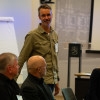This article is written by Danish Architecture Center for Nordic Innovation.
Nordic firms have proven to be excellent at creating high-quality, sustainable, and innovative architecture and city planning – something that is in high demand in rapidly developing China.
The five Nordic trade promotion organizations in China have interviewed three different Nordic firms with representation in China for their perspectives on the advantages of entering the Chinese market and their best advice for Nordic firms looking to get established abroad.
Demand for Nordic sustainability
Nordic solutions are in demand on China’s growing markets, and that opens opportunities for architecture firms and innovative companies with an eye to the Asian market.
Øivind Eftestøl, CEO at Polybo AS, a Norwegian construction technology firm, has experienced this first hand. When he established his first contact with China in 2013, he felt very well-received, and he was quickly motivated by the possibilities in the large Chinese market.
“I highly recommend looking toward the great market in China,” Øivind Eftestøl says today.
With Polybo AS, Øivind Eftestøl has developed a sustainable, modular system for the construction industry. When it comes to sustainability, in particular, China has a huge demand for new solutions – something worth noting as a Nordic firm looking for international adventures.
“China has, as most markets in the world, a big goal for a greener construction industry and for new and innovative solutions. These are very important selling points to bring to China,” explains Øivind Eftestøl, adding that Nordic firms can benefit from this: “It’s a great help to Nordic companies that China is very open to Nordic architecture and Nordic solutions.”
Zhao Jinyan is the Executive President of VELUX China, and he knows the Chinese market from within. When talking about the development China has experienced, Zhao Jinyan also emphasizes how crucial sustainable innovations are to the future of the country, and how this creates strong demand for Nordic solutions.
“Nordic solutions are really good at being sustainable – in knowledge, in product, and in service. And especially knowledge and service are something that the Chinese market is looking for,” Zhao Jinyan says. According to Zhao Jinyan, this demand for sustainable innovations combined with the sheer size of the Chinese market makes for great opportunities.
“There is, in many areas and in many industries, a wide scope of opportunities. I think many Nordic companies would benefit from starting in China; we have a population of 1.4 billion, and that makes for a huge potential,” he explains.
High-quality solutions
China’s rapid development has created not only strong demand for sustainable innovations, but also for high-quality solutions.
“China is a huge country, and we have experienced robust development over the past 40 years. But now the growth speed has slowed down, so we are reaching a turning point. Our focus for the future is changing from quantity to quality,” Zhao Jinyan explains.
According to Zhao Jinyan, one reason for the success of Velux in the Chinese market can be found in precisely this focus on both quality and sustainability when it comes to architecture and building components. The Danish firm has been active in China for more than 25 years, and throughout that time, the focus at Velux has been on offering high-quality products that improve quality of life in the built environment.
“At Velux we want to offer not only a better living environment, but also sustainable and environmental building solutions for the Chinese market,” explains Zhao Jinyan, adding: “China has huge potential in this area.”
In 2020 this demand in China for high-quality, sustainable solutions secured Swedish architecture and engineering firm, Sweco, a contract to develop a new sustainable urban district, the Hainan Future Industry Park, in southern China. Sweco has been working with sustainable projects in China for the last 20 years, and the Hainan project is no exception to the firm’s positive experiences working in a dynamic and quickly developing environment. According to Johannes Tüll, Chief Design Architect, Studio Director and International Director Stockholm at Sweco Architects, the opportunities in a forward-looking China actually motivated their work on the project.
“We want to be involved where the development in the world takes place. Where we can make a good and sustainable impact,” says Johannes Tüll. “For me, personally, I’m grateful to have the opportunity to work on a project like this. It has a sustainability focus, we have a client that is forward-thinking, we have a location that is fantastic, and a chance to do a great project. As a company, and as a group of architects and engineers, we are very grateful to be a part of this,” he explains.
Creating an international network
Establishing your firm as a foreigner in China requires both cultural understanding and a Chinese network that can introduce you to the local market. Øivind Eftestøl explains that his firm, Polybo AS, benefitted greatly from the network offered by the Norwegian embassy to newcomers in China.
“Before entering the huge market in China, you need to do your homework,” says Øivind Eftestøl.
“Use the Nordic network, like the embassies and the Nordic trade councils, to get input. They can help with all kinds of questions relating to cultural understanding, language and pitfalls, and how to protect the intellectual property rights of your product. To develop our network, including both Nordic countries that are already in China and Chinese companies, and to gain an even better understanding of the Chinese market and funding instruments, Polybo participated in several conferences and networks, both in Norway and China, hosted by the Nordic countries,” he explains.
Nordic Sustainable Cities
Through Nordic Sustainable Cities, Nordic Innovation is working on behalf of the five Nordic prime ministers to promote Nordic solutions for sustainable, livable and smart cities on a global scale. Part of the program is about showcasing and promoting export of Nordic solutions to urban sustainable development challenges in three major markets; North America, India and China.
Zhao Jinyan also emphasizes the importance of connecting with Chinese partners when entering the Chinese market as a Nordic firm.
“It’s a good idea to get a Chinese partner to help you in the beginning to gain a better understanding of this market more quickly,” Zhao Jinyan explains, continuing: “There are a lot of professional companies that can help new players to gain experience. Just be aware that for different companies and different industries, you will need to contact different market players.”
Learning from China
An expanded international network can potentially lead to new inventions and fresh inspiration. This is what the architects at Sweco’s offices in China have experienced. For them, one key learning was the importance of teaming up with and learning from Chinese partners. Carlo Negri, Chief Design Architect and International Director at Sweco Architects, explains how the design process for the Hainan office project has been defined not only by interdisciplinary collaborations within Sweco, but also by a fruitful dialogue with local partners.
“Our process is very much about an integrated process. We work together with our experts here at Sweco; our energy experts, water experts, and building engineers who design together with the architects. It is important that we don’t just do that from within Sweco, but that we also do it together with our local design institute and our partners on this project. This is key to ensuring that our unique design meets all the requirements of the project, but also merges the international mindset with innovations that are already within China itself,” explains Carlo Negri.
Anders Neregård, Chief Design Architect, Studio Director and Chief Digital Officer at Sweco Architects, also stresses the benefits of working in an international milieu. He is convinced that working in China has expanded the team’s way of thinking – a learning they will bring back with them to Sweden.
“When we work in China, it’s an interesting and different kind of process than when we work in Europe or in Sweden. And for us, I think, that has been the most challenging part, and that has helped us. We will bring that mindset back to Europe as well,” Anders Neregård concludes.





